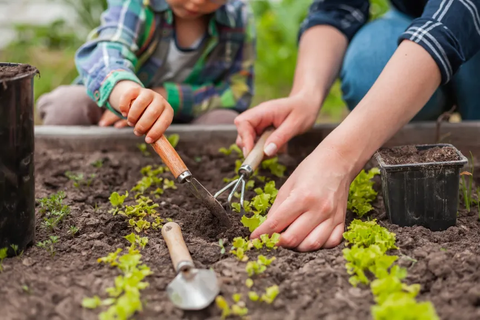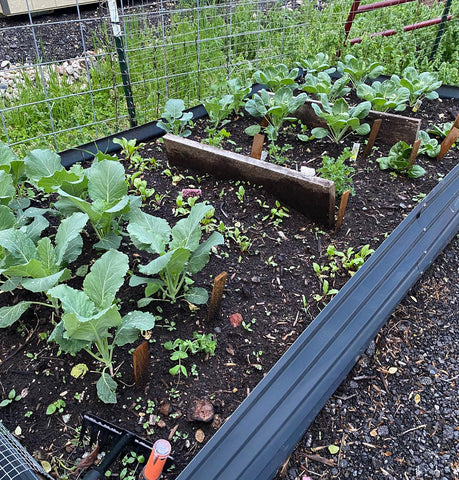The beauty of a garden lies not only in the greenery but also in the vibrant colors it showcases. Floral garden beds are a celebration of nature's palette, where you can immerse yourself in a riot of colors. Whether you're a seasoned gardener or a novice, designing a floral garden bed can be a fulfilling and creative endeavor. In this blog, we will explore tips and the process of creating a colorful floral garden bed that will enchant your senses and transform your outdoor space into a living work of art.

1. Planning Your Floral Garden Bed
- Choose a Location: Select a sunny spot for your floral garden bed. Most flowering plants thrive in full sun, but some can tolerate partial shade.
- Consider Blooming Seasons: Plan for a sequence of blooms throughout the growing season. This ensures that your garden bed remains colorful from spring to fall.
- Select a Color Palette: Decide on the color scheme you want. You can go for a harmonious palette with similar colors or create contrast by combining complementary colors
2. Choosing the Right Flowers
- Native Plants: Consider using native wildflowers. They are well-adapted to your region and provide essential nectar for local pollinators.
- Perennials and Annuals: A mix of perennials (plants that return each year) and annuals (plants that complete their life cycle in one year) offers both consistency and variety.
- Height Variation: Choose plants of different heights to create visual interest. Taller plants can act as a backdrop for shorter ones.

3. Soil Preparation
- Soil Testing: Conduct a soil test to determine the pH and nutrient levels of your soil. You can amend the soil accordingly to create the right conditions for your chosen plants.
- Amendments: Incorporate organic matter like compost to improve soil structure and fertility.
4. Planting and Designing Your Bed
- Spacing: Follow the planting instructions for each flower. Proper spacing is essential to prevent overcrowding and competition for resources.
- Layering: Arrange plants in layers with taller ones at the back and shorter ones at the front. This creates a sense of depth and dimension.
- Grouping: Plant flowers in clusters or drifts of the same species or color. This creates impact and draws the eye to focal points
5. Maintenance
- Watering: Provide adequate water, especially during dry spells. Use a drip irrigation or soaker hose to water directly at the plant's base, preventing moisture from reaching the leaves.
- Mulching: Apply a layer of organic mulch to retain moisture, regulate soil temperature, and suppress weeds.
- Deadheading: Regularly remove spent flowers to encourage more blooms.
- Pruning: Prune back overgrown or leggy plants to maintain their shape and encourage bushier growth.

6. Attracting Pollinators
- Native Plants: Including native plants in your floral bed is a surefire way to attract local pollinators like bees and butterflies.
- Diversity: A variety of flower shapes and colors can attract a wide range of pollinators.
7. Seasonal Care
- Winter Protection: Some perennials may benefit from a layer of mulch for winter protection. Be sure to remove it in the spring.
- Dividing and Transplanting: Over time, some perennials may become overcrowded. Dividing and transplanting them can rejuvenate the bed.
8. Continuous Bloom
- Succession Planting: To ensure continuous blooms, consider planting some annuals or biennials that reseed themselves.
9. Garden Accessories
- Pathways and Borders: Define your garden bed with pathways or borders to create a neat and organized look.
- Decorative Elements: Consider adding garden ornaments, statues, or trellises for a touch of artistry.

10. Fertilization
- Balanced Fertilizer: Use a balanced, slow-release fertilizer in the spring to provide essential nutrients to your plants.
11. Enjoying Your Floral Garden Bed
- Cut Flowers: Don't hesitate to cut some of your blooms to bring indoors and brighten up your living space.
- Relax and Watch: Spend time in your garden bed, observing the visiting pollinators and enjoying the beauty you've created.
Recommendations for Beautiful Flower Color Combinations:
- Monochromatic Elegance: Create a soothing and elegant bed by using various shades of a single color. For example, different shades of blue, from pale sky blue to deep navy, can create a calming and cohesive look.
- Warm Sunset Hues: Combine warm colors like red, orange, and yellow for a bed that mimics the colors of a vibrant sunset. Include flowers like marigolds, zinnias, and rudbeckias.
- Cottage Garden Charm: Achieve a cottage garden feel by mixing a multitude of colors in a seemingly random but harmonious way. Include cottage garden favorites like roses, daisies, and delphiniums.
- Classic White and Green: For a timeless and elegant look, use white flowers like roses, daisies, and lilies paired with green foliage. This combination is especially stunning in the evening.
- Complementary Contrasts: Combine flowers with complementary colors to create dynamic contrast. For instance, pair purple and yellow flowers for a lively and eye-catching display.
- Soft Pastels: Create a gentle and romantic atmosphere by using soft pastel colors like blush pink, lavender, and pale yellow.
- Bold and Bright: If you want your garden to make a statement, opt for bold and bright colors like fiery red, electric orange, and vibrant fuchsia.
- Woodland Serenity: For a more natural and woodland-inspired look, use earthy colors like browns, greens, and soft blues.
Conclusion
Designing floral garden beds that explode with a riot of color is a delightful way to infuse life and energy into your outdoor space. By incorporating these recommendations for beautiful flower color combinations into your floral garden bed, you can create a visual masterpiece that will bring joy and delight to your outdoor space. Whether you prefer a soothing monochromatic scheme or a riot of contrasting colors, your garden bed will be a reflection of your personality and a haven for nature's wonders.









